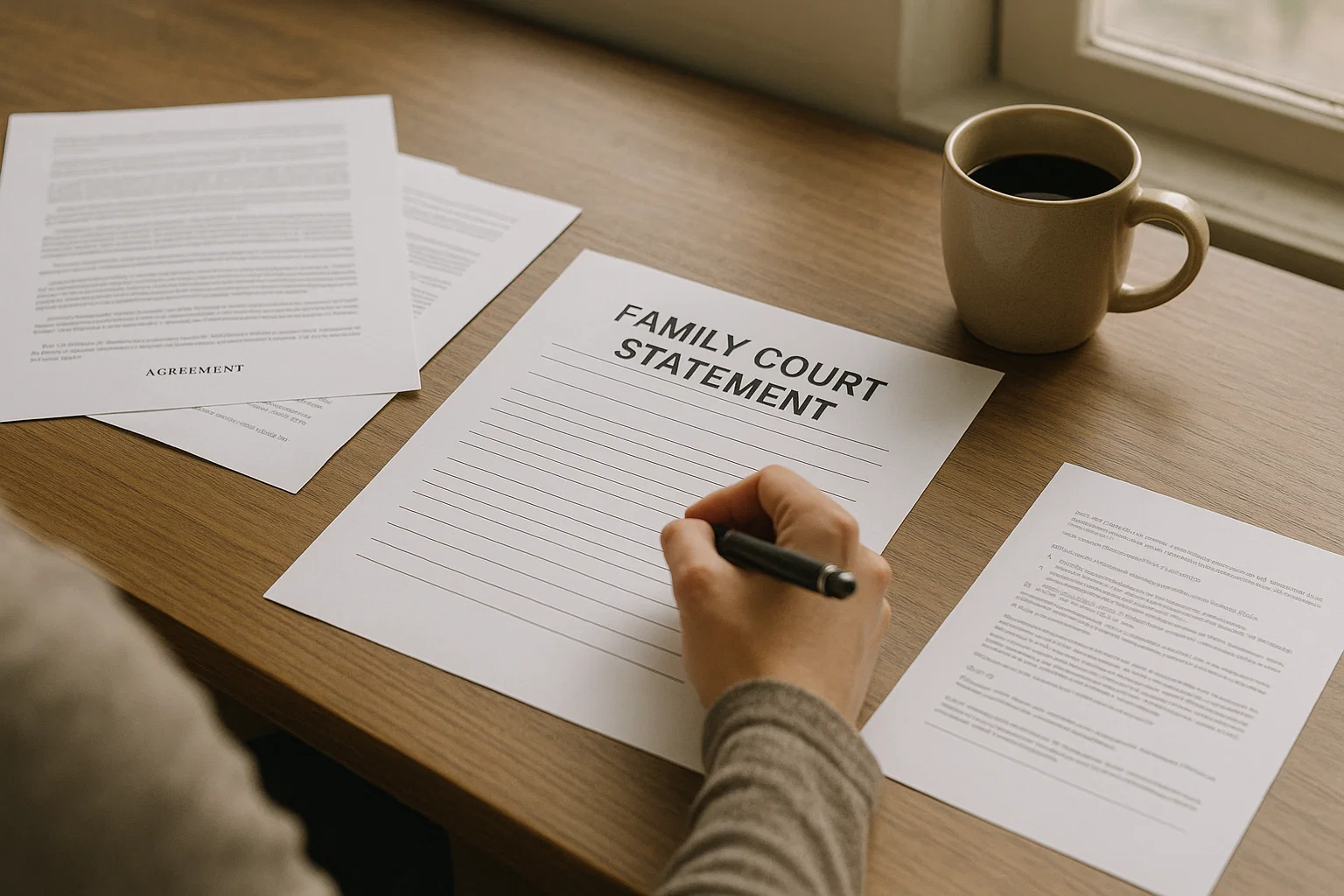Think of it this way: judges don’t want drama, they want details. They’re not looking for who can write the saddest story they want facts they can trust. Once you understand what they expect, it’s much easier to write something that earns respect instead of irritation.
Let’s walk through how to do that step by step and end with a simple template you can actually use.
Why Your Statement Matters So Much
In family court, a written statement (also called a “witness statement” or “personal statement”) is your version of events, written in your own words. It helps the judge understand the situation your side of the story without you being interrupted or rushed.
It’s used in many cases:
- Child custody or access disputes
- Divorce or financial separation
- Domestic abuse claims
- Disagreements about property or parenting
This document often becomes part of the official court record, which means your wording, tone, and structure matter. It’s not just paperwork it’s your voice on paper.
What Judges Actually Want (and What Annoys Them)
Here’s something people don’t always realise: judges read dozens of statements a week. They can tell within seconds if one is thoughtful or messy, honest or emotional.
So, what makes a judge sit up and listen?
- Facts, not feelings. Stick to what you know, saw, or experienced.
- Short paragraphs, clear sentences. Make it easy to follow.
- Dates and evidence. Be precise “on 12th June 2024” is stronger than “last summer.”
- Neutral language. Instead of “He’s a terrible father,” say “He often missed contact weekends.”
And what annoys judges most?
- Long rants about character.
- Blame-filled statements.
- Emotional exaggerations like “always” or “never.”
- Repeating the same point ten different ways.
Remember: the goal isn’t to vent it’s to inform.
The Golden Rules Before You Start Writing
Before you put fingers to keyboard, take a breath and plan. Here’s what will save you from rewriting it all later.
- Stick to what’s relevant. Only include details that help the court make a decision.
- Be respectful. Even if you’re angry or hurt, this isn’t the place for insults.
- Stay calm and factual. Judges admire restraint and clarity.
- Avoid guessing. If you don’t know something for sure, don’t state it as fact.
- Keep it concise. Around 2–3 pages is perfect enough to cover key details without losing focus.
A judge once said in open court: “The best statements are the ones I can read in under five minutes and still understand everything that matters.”
How To Write a Statement for Family Court (Step-by-Step)
Now let’s get practical. Here’s exactly how to structure it and what to include in each part.
1. Header Information
Start your document clearly.
Example:
This makes it look professional from the start.
2. Opening Paragraph
Introduce yourself and your connection to the case. Keep it simple.
Example:
My name is Sarah Taylor. I am the mother of two children, aged 7 and 10. I make this statement in support of my application for a child arrangements order regarding my children’s living and contact arrangements.
Avoid emotional openings like “I have been treated unfairly” keep tone factual.
3. The Story (Facts Only)
This is the heart of your statement your side of the story. Use clear subheadings if it helps:
Background
Give a brief history of the relationship or situation.
I met the respondent in 2010, and we married in 2013. We separated in May 2022.
Current Circumstances
Explain where everyone lives, who the children stay with, and what the current routine looks like.
The children currently live with me during school weeks and spend alternate weekends with their father.
Issues for the Court
Outline what needs to be resolved custody, contact, finances, etc.
I am seeking an order confirming that the children live primarily with me and that contact with their father continues every other weekend.
Evidence or Examples
Whenever possible, back up your points.
For example, on 14th March 2025, the respondent did not attend the scheduled school meeting.
Stick to dates, details, and patterns not feelings or opinions.
4. Your Requests (What You’re Asking the Court to Do)
Be polite, brief, and specific.
Example:
I respectfully request the Court to:
- Confirm the children’s residence with me.
- Maintain regular contact arrangements with the respondent.
- Encourage communication through the school or email only.
This part should read more like a summary than an argument.
5. Ending Statement
Wrap it up with respect and clarity.
Example:
I make this statement truthfully and in good faith to assist the Court in reaching a fair decision.
Signed: __________________________
Date: ___________________________
And that’s it. Simple, clean, and clear.
Family Court Statement Template Example
Here’s a quick sample you can use or adapt for your own case.
IN THE FAMILY COURT AT [CITY]
Case Number: [Insert Number]
Between:
[Your Full Name] (Applicant)
and
[Other Party’s Full Name] (Respondent)
WITNESS STATEMENT OF [YOUR NAME]
Date: [Insert Date]
Background
Write a short background of your relationship or family situation. Keep it factual and brief.
Current Circumstances
Describe who the children live with, their schooling, and current routines.
Concerns or Issues
Outline the problems or disagreements that brought you to court.
Supporting Information
Include relevant examples, dates, and evidence.
What You’re Asking the Court For
List your requests clearly and respectfully.
Declaration
I believe the facts stated in this witness statement are true.
Signed: __________________
Dated: __________________
How Long Should a Family Court Statement Be?
Most judges prefer no longer than three pages. Shorter is fine if you’ve said everything you need to. If you write ten pages, chances are you’re repeating yourself.
A good test? If you can read it aloud in under 10 minutes and it still feels complete, you’ve nailed the length.
Pro Tips to Strengthen Your Statement
A few small things make a big difference:
- Format neatly. Use 1.5 line spacing and size 12 font.
- Write in first person. (“I am”, “I believe”, “I observed”) it sounds genuine.
- Avoid slang or texting style. Judges dislike “u” or “lol” in any context.
- Proofread with fresh eyes. Or better, ask a friend who isn’t emotionally involved to check it.
- Save as PDF. This ensures formatting stays intact when you submit it.
If you’re really unsure, you can even run your draft through a tool like Spinbot to reword unclear sentences or fix repetition without losing your meaning.
Quick Checklist Before You Submit
✅ Case number and court details are correct.
✅ All dates and names are accurate.
✅ Each paragraph focuses on one clear point.
✅ Tone is polite, calm, and factual.
✅ No spelling or grammar mistakes.
✅ Signed and dated at the end.
Your final read should feel like you’re talking directly to the judge steady, honest, and respectful.
Writing for family court isn’t about sounding perfect. It’s about showing the truth in a way that helps the judge make the right call. When you write with focus and sincerity not frustration your words carry more power than you might think.
So, take a deep breath, stay calm, and write it like you mean it with truth, structure, and respect.

Rachel combines her technical expertise with a flair for clear, accessible writing. A graduate of the University of Edinburgh, she specializes in creating detailed tech-focused content, Govt Jobs, Payslips that educates our readers about the latest in web development and SEO tools at Spinbot blog.
